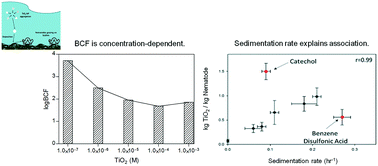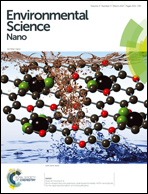Interactions of TiO2 nanoparticles and the freshwater nematode Plectus aquatilis: particle properties, kinetic parameters and bioconcentration factors†
Abstract
Principles for determining uptake kinetics and bioconcentration factors for nanoparticles and test organisms have only been cursorily explored. Here we report the derivation of bioconcentration factors (BCFs) and the role of surface functionalization in the interactions between the nematode Plectus aquatilis and titanium dioxide nanoparticles (TiO2 NPs) dispersed in freshwater. Because of the high background concentration of titanium in natural waters, TiO2 NPs irradiated to produce 48V labeled TiO2 NPs, or doped with 1% niobium, were used to determine BCFs taking either an equilibrium partitioning or a kinetic modelling approach. The BCFs based on equilibrium partitioning increased from 71 (±17) L kg−1 at the highest exposure concentrations to 5.1 (±3.2) × 103 L kg−1 at the lowest exposure concentration, indicating that this approach is not valid. A kinetic modeling approach, based on the uptake rate and elimination rates for a two-phase elimination, best reflected the experimental data and was then used to determine BCFs. To further rationalize the kinetic interactions between the TiO2 NPs and the nematode, organisms were exposed to surface-functionalized TiO2 NPs with positively charged, negatively charged, steric stabilizing and environmentally relevant coatings. Correlations between the extent of TiO2 NP association (i.e. attached and internalized) with the nematode, and TiO2 NP properties, were examined. For all parameters considered, association of the surface functionalized TiO2 NPs with the nematode best correlated with the TiO2 NP sedimentation rate. These results indicate that concepts developed for hydrophobic contaminants are not applicable to nanoparticles and concepts specific to nanoparticles will be of greater utility.



 Please wait while we load your content...
Please wait while we load your content...